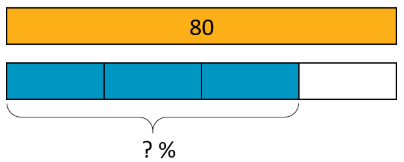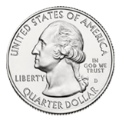18.2: Percentages and Tape Diagrams
- Page ID
- 39950
Lesson
Let's use tape diagrams to understand percentages.
Exercise \(\PageIndex{1}\): Notice and Wonder: Tape Diagrams
What do you notice? What do you wonder?

Exercise \(\PageIndex{2}\): Revisiting Jada's Puppy
Jada has a new puppy that weighs 9 pounds. It is now at about 20% of its adult weight.
- Here is a diagram that Jada drew about the weight of her puppy.

- The adult weight of the puppy will be 45 pounds. How can you see that in the diagram?
- What fraction of its adult weight is the puppy now? How can you see that in the diagram?
- Jada’s friend has a dog that weighs 90 pounds. Here is a diagram Jada drew that represents the weight of her friend’s dog and the weight of her puppy.

- How many times greater is the dog’s weight than the puppy’s?
- Compare the weight of the puppy and the dog using fractions.
- Compare the weight of the puppy and the dog using percentages.
Exercise \(\PageIndex{3}\): 5 Dollars
Noah has $5.
-
- Elena has 40% as much as Noah. How much does Elena have?
- Compare Elena’s and Noah’s money using fractions. Draw a diagram to illustrate.
-
- Diego has 150% as much as Noah. How much does Diego have?
- Compare Diego’s and Noah’s money using fractions. Draw a diagram to illustrate.
Exercise \(\PageIndex{4}\): Staying Hydrated
During the first part of a hike, Andre drank 1.5 liters of the water he brought.
- If this is 50% of the water he brought, how much water did he bring?
- If he drank 80% of his water on his entire hike, how much did he drink?
Are you ready for more?
Decide if each scenario is possible.
- Andre plans to bring his dog on his next hike, along with 150% as much water as he brought on this hike.
- Andre plans to drink 150% of the water he brought on his hike.
Summary
Tape diagrams can help us make sense of percentages.
Consider two problems that we solved earlier using double number lines and tables: “What is 30% of 50 pounds?” and “What is 100% of a number if 140% of it is 28?”
Here is a tape diagram that shows that 30% of 50 pounds is 15 pounds.

This diagram shows that if 140% of some number is 28, then that number must be 20.

Glossary Entries
Definition: Percent
The word percent means “for each 100.” The symbol for percent is %.
For example, a quarter is worth 25 cents, and a dollar is worth 100 cents. We can say that a quarter is worth 25% of a dollar.


Definition: Percentage
A percentage is a rate per 100.
For example, a fish tank can hold 36 liters. Right now there is 27 liters of water in the tank. The percentage of the tank that is full is 75%.

Practice
Exercise \(\PageIndex{5}\)
Here is a tape diagram that shows how far two students walked.

- What percentage of Priya’s distance did Tyler walk?
- What percentage of Tyler’s distance did Priya walk?
Exercise \(\PageIndex{6}\)
A bakery makes 40 different flavors of muffins. 25% of the flavors have chocolate as one of the ingredients. Draw a tape diagram to show how many flavors have chocolate and how many don’t.
Exercise \(\PageIndex{7}\)
There are 70 students in the school band. 40% of them are sixth graders, 20% are seventh graders, and the rest are eighth graders.
- How many band members are sixth graders?
- How many band members are seventh graders?
- What percentage of the band members are eighth graders? Explain your reasoning.
Exercise \(\PageIndex{8}\)
Jada has a monthly budget for her cell phone bill. Last month she spent 120% of her budget, and the bill was $60. What is Jada’s monthly budget? Explain or show your reasoning.
(From Unit 3.4.2)
Exercise \(\PageIndex{9}\)
Which is a better deal, 5 tickets for $12.50 or 8 tickets for $20.16? Explain your reasoning.
(From Unit 3.3.5)
Exercise \(\PageIndex{10}\)
An athlete runs 8 miles in 50 minutes on a treadmill. At this rate:
- How long will it take the athlete to run 9 miles?
- How far can the athlete run in 1 hour?
(From Unit 3.3.4)

